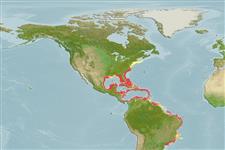Classification / Names
Common names from other countries
Main reference
Size / Weight / Age
Max length : 86.3 cm TL male/unsexed; (Ref. 9626); common length : 40.0 cm TL male/unsexed; (Ref. 55); max. published weight: 4.1 kg (Ref. 40637); max. reported age: 14 years (Ref. 3090)
Length at first maturity
Lm 22.5, range 15 - 31 cm
Environment
Marine; reef-associated; depth range 0 - 180 m (Ref. 10795), usually 10 - 70 m (Ref. 55229)
Climate / Range
Subtropical, preferred 26°C (Ref. 107945); 42°N - 26°S, 98°W - 31°W (Ref. 55229)
Distribution
Western Atlantic: extending northward to Massachusetts, USA and Bermuda and southward to southeastern Brazil, in Gulf of Mexico and Antilles (Anderson, pers. comm.). Most common in the Bahamas, off south Florida and throughout the Caribbean. Lutjanus ambiguus (Poey, 1860), an intergeneric hybrid with Lutjanus synagris (Linnaeus) as demonstrated by Loftus (1992: Ref. 33006), followed by McEachran &. Fechhelm (2005: Ref. 78464).
Countries | FAO areas | Ecosystems | Occurrences | Introductions
Short description
Dorsal
spines
(total): 10;
Dorsal
soft rays
(total): 12-14;
Anal
spines: 3;
Anal
soft rays: 8 - 9. Head relatively small, lower jaw projecting slightly beyond the upper. Scale rows on back rising obliquely above lateral line. Back and upper sides blue to violet with scattered yellow spots. A prominent mid-lateral yellow band running from the snout to the caudal fin base. The lower sides and belly whitish with narrow reddish and yellow stripes; the dorsal and caudal fins yellow; the anal and pelvic fins whitish.
IUCN Red List Status (Ref. 115185)
Threat to humans
Reports of ciguatera poisoning (Ref. 30911)
Human uses
Fisheries: commercial; aquaculture: commercial; gamefish: yes; aquarium: public aquariums
Tools
Special reports
Download XML
Internet sources
Estimates of some properties based on models
Phylogenetic diversity index
PD50 = 1.0000 many relatives (e.g. carps) 0.5 - 2.0 few relatives (e.g. lungfishes)
Trophic Level
4.0 ±0.3 se; Based on diet studies.
Resilience
Low, minimum population doubling time 4.5 - 14 years (K=0.10-0.16; tm=2; tmax=14)
Vulnerability
High vulnerability (65 of 100)
Price category
